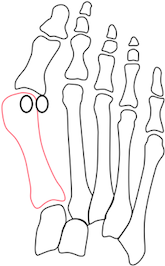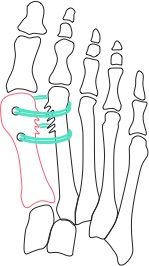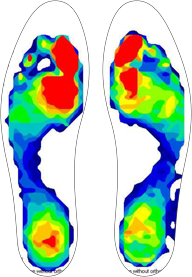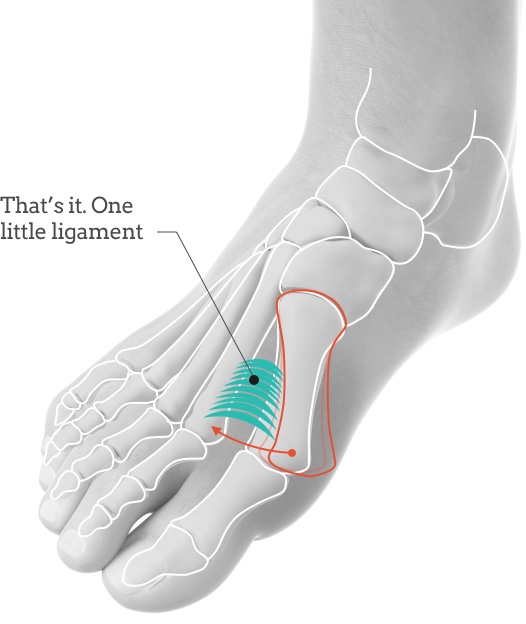Syndesmosis Bunion Surgery
The Syndesmosis procedure is a simple solution to a complex problem. This form of bunion surgery is a potential game-changer in the correction of this condition. At the Center for Syndesmosis Bunion Surgery in Hong Kong, we have over 35 years of experience, during which time we’ve treated over 2,500 feet, proving that there is a proven way to healthier feet. Repeatedly. Consistently.
Conventionally, bunion surgery in HK and rest of the world is done using a technique that involves breaking the affected bones, resizing it and refitting it into your foot, so that your foot regains its desired shape and form. But this process can be painful and can have a long recovery period.
If the root of the complex problem is a ligament failure that causes the bones to collapse, the most logical way to reverse the process is to realign the displaced bones and then address the ligament issue to prevent bone from displacement again.
The Process
DEFORM
The metatarsus primus varus (MVP) is created when the first metatarsal gives in to the constant stress of daily activity and starts to be pushed away from the other four metatarsals. The bones of the medial column fall apart and the sesamoid bones become displaced.

RE-ALIGN
The displaced first metatarsal can be readily and naturally re-erected to its normal position by simply tying it to the adjacent second metatarsal bone with surgical sutures without cutting any bones or fusing any joints.

STABILIZE
A unique bunion surgery for Hong Kong patients creates an environment that induces the natural formation of a new ligament – the Syndesmosis – to re-stabilize the first metatarsal and prevent recurrence.

RESTORE
Once displaced bones are holistically re-aligned and re-stabilized, the normal mechanics of the entire medial column can then be restored. The arches reform and strengthen, and the big toe regains function as if the deformity had not existed before.


Your body was designed to heal itself
Your body’s own ability to heal itself is the key to restoring and retaining optimal foot function. In fact, this natural ability is what we harness as part of our Syndesmosis bunion surgery in HK. A Syndesmosis is a common anatomical structure in the human body that connects and stabilizes two parallel long bones to each other. Essentially, it is a fibrous joint where ligaments connect two adjacent bones to each other. The most well-known Syndesmoses exist in your legs and forearms.
Syndesmosis bunion surgery utilizes the body’s innate healing response to produce a brand new fibrous connecting bridge between the first and second metatarsal bones. Identical to the healing of a wound, any healthy body is capable of forming this biological structure, without any artificial implant or tissue transplantation. We simply create the right and conducive environment that facilitates the generation of the Syndesmosis ligament. Your body does the rest.
The Syndesmosis bunion surgery in Hong Kong we perform is a special technique. It leaves each bone and joint fully intact by addressing the true underlying ligament pathology. Once the Syndesmosis forms naturally over the course of 6 months, it is the only mechanism needed to critically stabilize previously unstable first metatarsal bone. Plus, because the Syndesmosis is a living structure – it will maintain its own natural upkeep. The Syndesmosis is yours for life.
A BETTER WAY TO HEALTHIER FEET
35
YEARS
Experience
2K
FEET
restored
Syndesmosis bunion surgery is an evidence-based correction procedure that has broken the bone-cutting tradition. It has remarkably overcome not just one, but most of the critical challenges faced in similar surgeries today. Some of its benefits include –
- Walking is allowed immediately after the procedure, so both feet can be done at the same time.
- One single bunion surgery technique provides satisfactory correction for all levels of severities.
- The recurrence rate, especially long-term, is low due to the unique permanence of the Syndesmosis.
- Big toe function can be restored significantly and consistently, proven by foot function scan studies and the disappearance of metatarsal calluses.
- Unrestricted activities and shoes are permitted six months after the bunion surgery.
RECOVERY AFTER BUNION SURGERY
Recovery after the Syndesmosis bunion surgery for HK patients is not as long or painful as other types of bunion surgery. This is because this procedure is based on a natural process of ligament formation, and therefore it is consistent, constant and predictable. Here are a few things to know about recovery with this bunion surgery:
- Syndesmosis formation – There is no known method to confirm ‘completion’ of the Syndesmosis’ formation. But our experience in bunion surgery suggests gradual return to normal walking after 3 months and unrestricted activities and shoes after 6 months.
- Less pain – Bunion surgery HK patients of ours, who previously had a bone-cutting procedure elsewhere, report much less pain after Syndesmosis bunion surgery. The vast majority of our patients need to take only anti-inflammatories (Arcoxia) and mild pain relievers (Tylenol #1) for 2-3 days after bunion surgery in HK.
- Immediate weight-bearing – Full weight bearing is permitted any time after both one-foot and two-feet bunion surgery procedure. You can resume walking the day following bunion surgery in HK. Most patients prefer crutches for security for the first few days.
- Postoperative protective footwear – A patented and awarded footwear has been specially designed to protect the bunion surgery hk patient and allow walking 5,000 steps a day after the no-bone-breaking syndesmosis procedure. It is to be worn for 3 months to protect the internal holding sutures and to facilitate the syndesmosis formation. Then, you can start to wear comfortable trainers with specific foot orthotics for 2-3 months until your foot is completely rehabilitated.
- Restricted walking – Swelling is normal, and foot elevation is recommended whenever possible during the first postoperative month. For worry-free recovery, walking is generally restricted to no more than 5,000 steps a day for the second and third months. Crutches are recommended for outdoor walking. A strolling pace is critical to reduce ground impact stress on the internal holding sutures in your feet until the Syndesmosis ligament is fully formed. Then, after consulting with our bunion surgery Hong Kong doctor, you can start to slowly level-up with your daily activity, including running and high-heels.
Possible complications
Every surgical procedure, no matter how small or large, always has the risk of possible complications. Since the syndesmosis procedure does not involve breaking bones or fusing joints, at least it is spared of all their related complications. However, over our past 2,500 cases, we have also experienced the following more common complications with the syndesmosis procedure.
- General complications associated with surgical wounds
a. Postoperative bleeding
b. Nerve injury causing numbness sensation in the wound area
c. Early or late wound infection
- Complications specific to the syndesmosis procedure
a. Technique-related
i. Overcorrection
ii. Second toe deviation
iii. Intraoperative metatarsal fracture
b. Cooperation-related
i. Early partial deformity recurrence
ii. Second metatarsal stress fracture
iii. Joint stiffness
- Constitutional
a. Late 2-3 intermetatarsal separation due to underlying weak ligaments
b. Residual minor bunion/hallux valgus due to structural differences
c. Progression of pre-existing arthritis




